Abstract
This study was designed to determine whether human hearts release adenosine, a possible regulator of coronary flow, during temporary myocardial ischemia and, if so, to examine the mechanisms involved. Release of adenosine from canine hearts had been reported during reactive hyperemia following brief coronary occlusion, and we initially confirmed this observation in six dogs hearts. Angina was then produced in 15 patients with anginal syndrome and severe coronary atherosclerosis by rapid atrial pacing during diagnostic studies. In 13 of these patients, adenosine appeared in coronary sinus blood, at a mean level of 40 nmol/100 ml blood (SE = ±9). In 11 of these 13, adenosine was not detectable in control or recovery samples; when measured, there was concomitant production of lactate and minimal leakage of K+, but no significant release of creatine phosphokinase, lactic acid dehydrogenase, creatine, or Na+.
There was no detectable release of adenosine by hearts during pacing or exercise in three control groups of patients: nine with anginal syndrome and severe coronary atherosclerosis who did not develop angina or produce lactate during rapid pacing, five with normal coronaries and no myocardial disease, and three with normal coronaries but with left ventricular failure.
The results indicate that human hearts release significant amounts of adenosine during severe regional myocardial ischemia and anaerobic metabolism. Adenosine release might provide a useful supplementary index of the early effects of ischemia on myocardial metabolism, and might influence regional coronary flow during or after angina pectoris.
Full text
PDF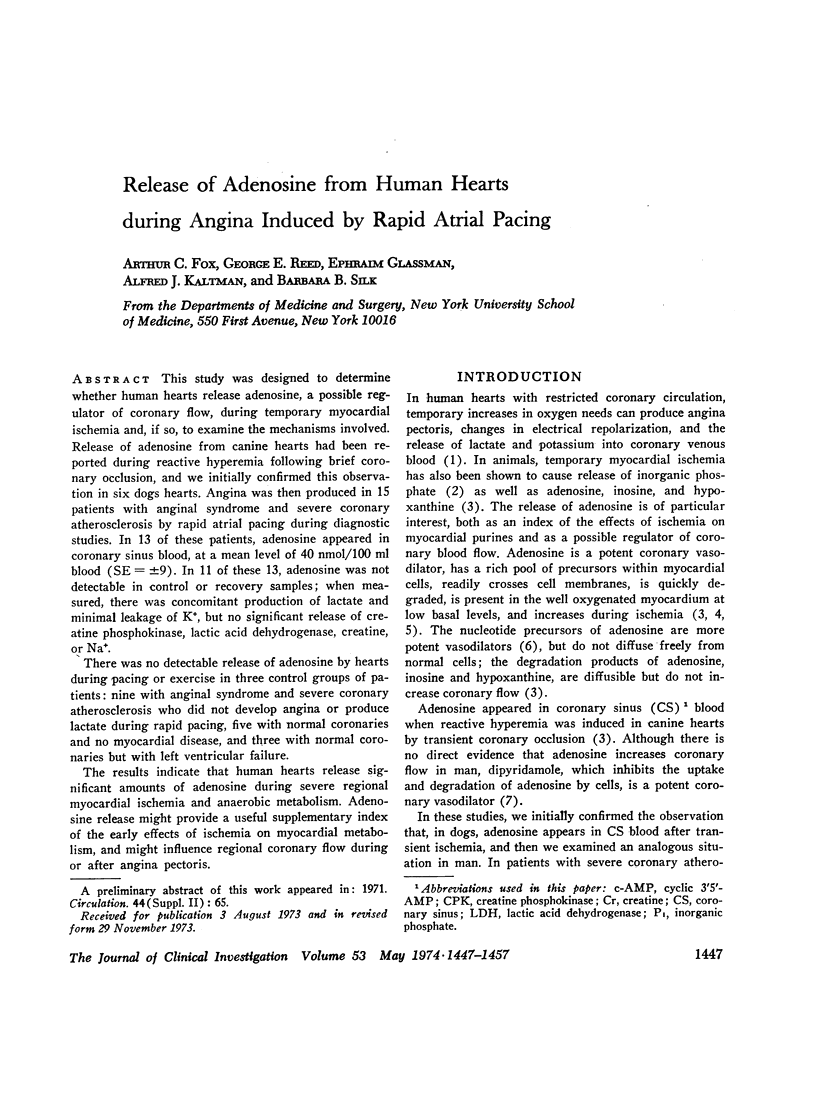
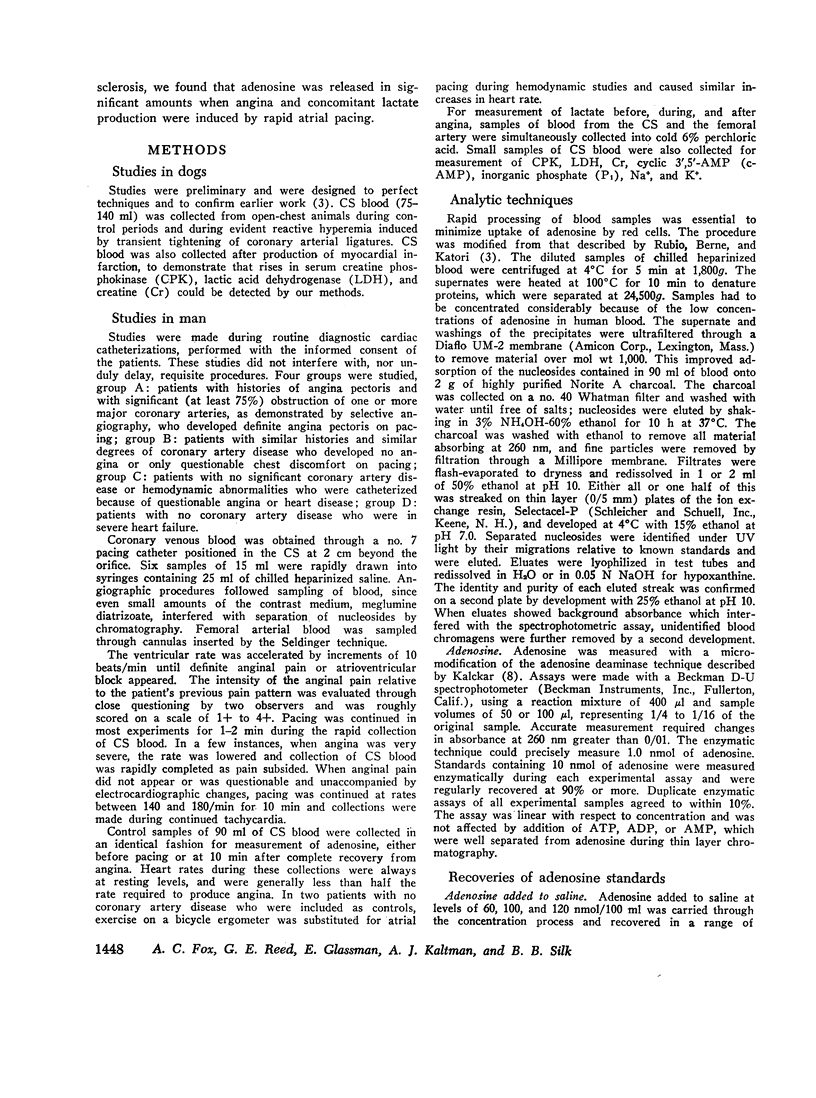
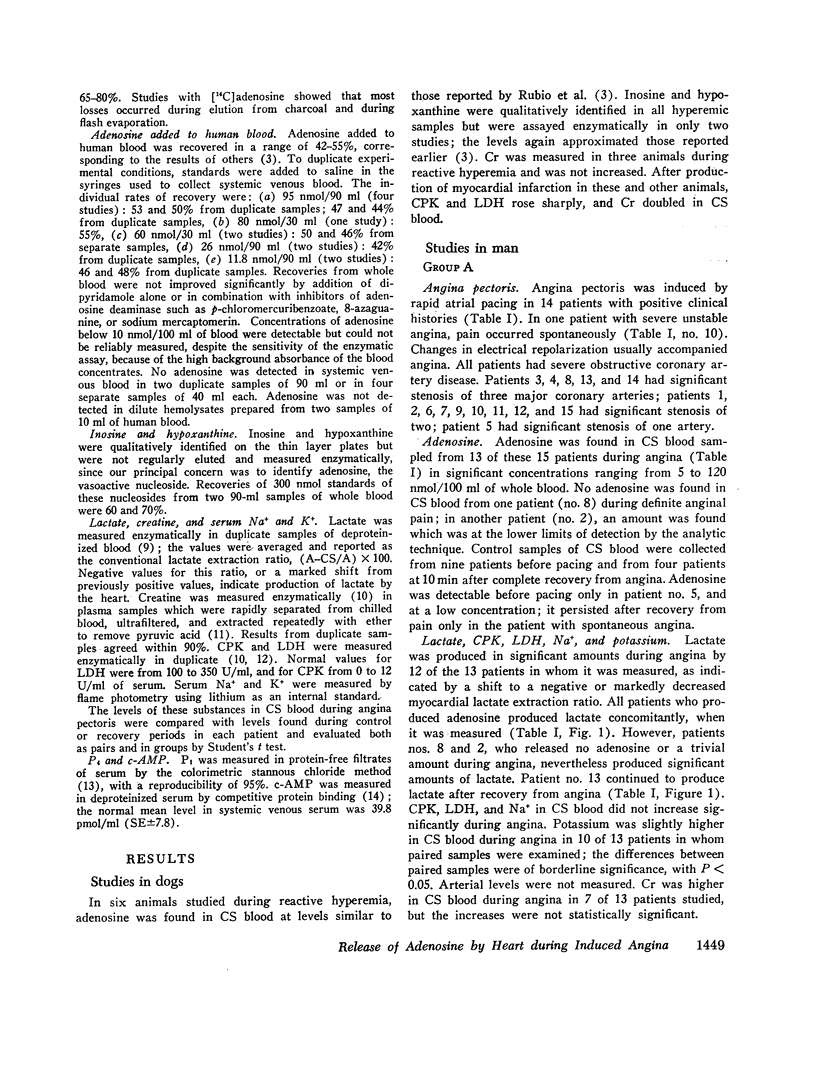
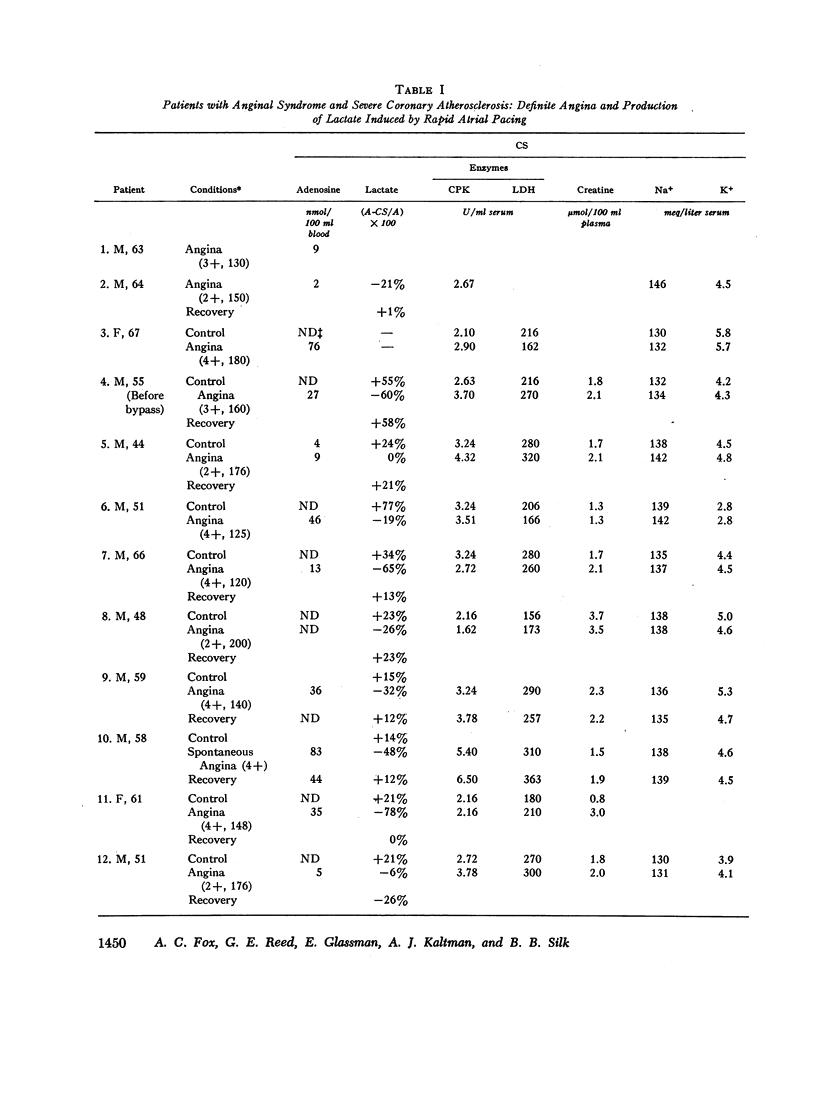
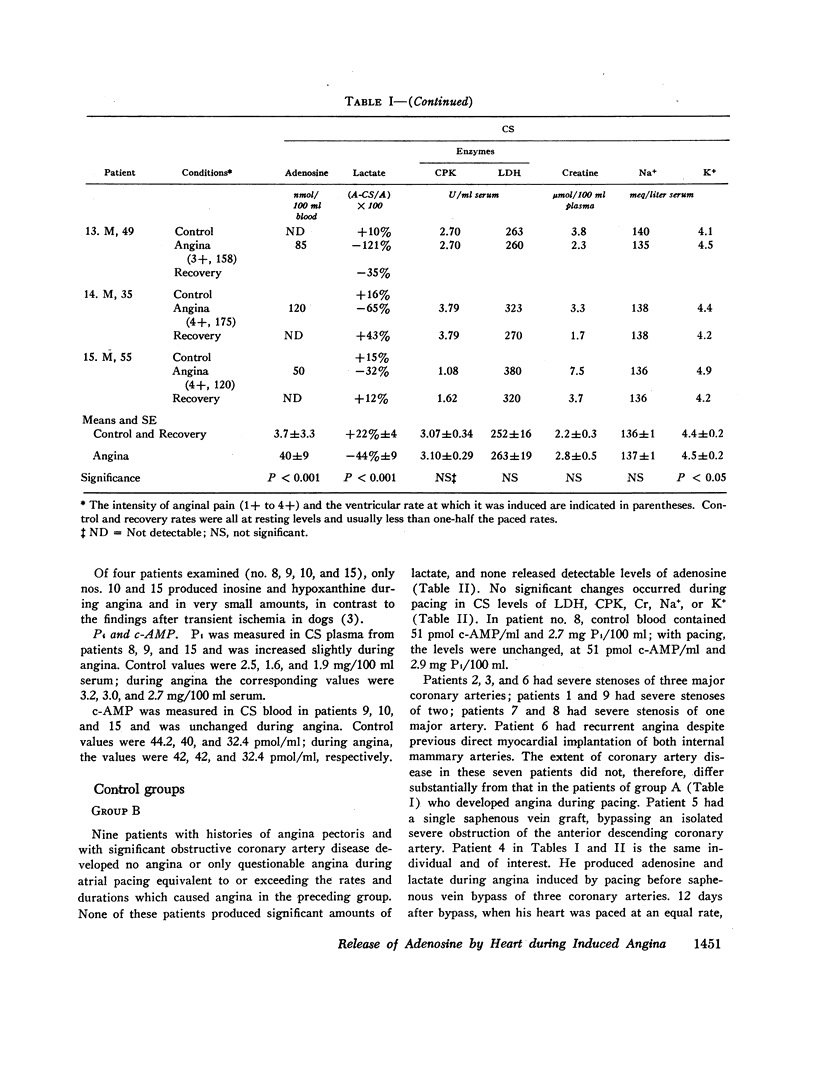
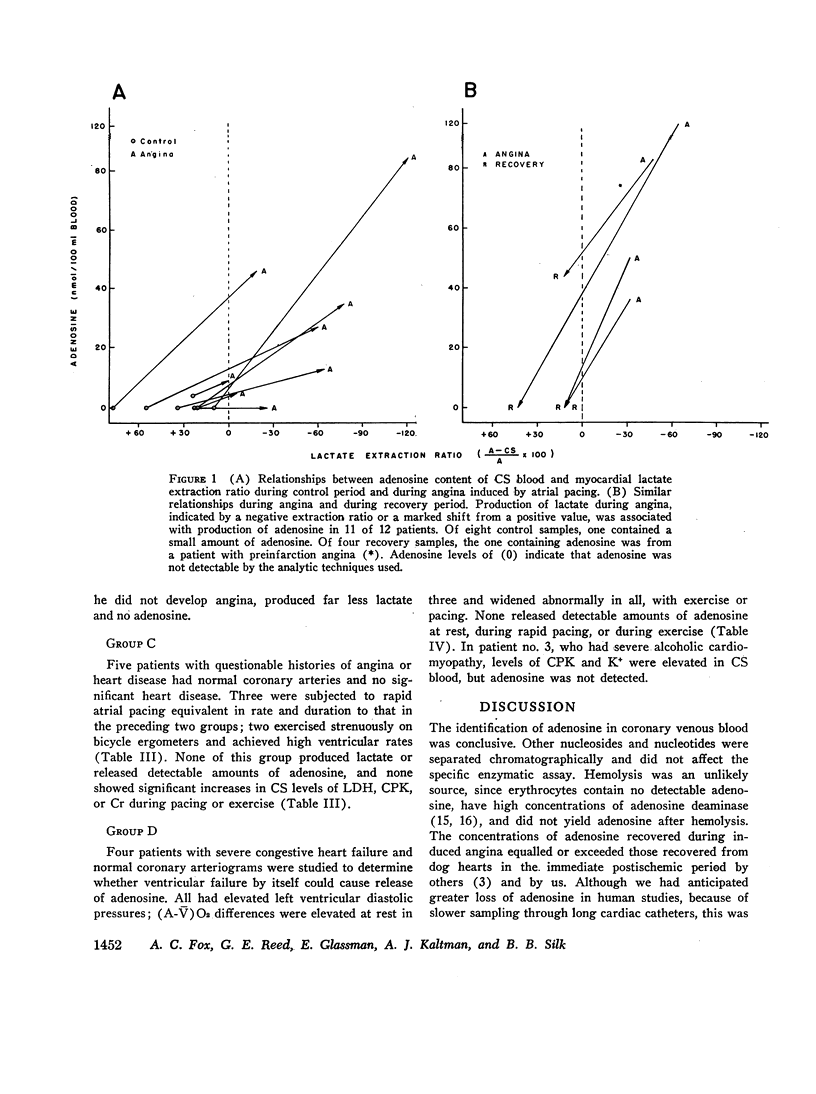
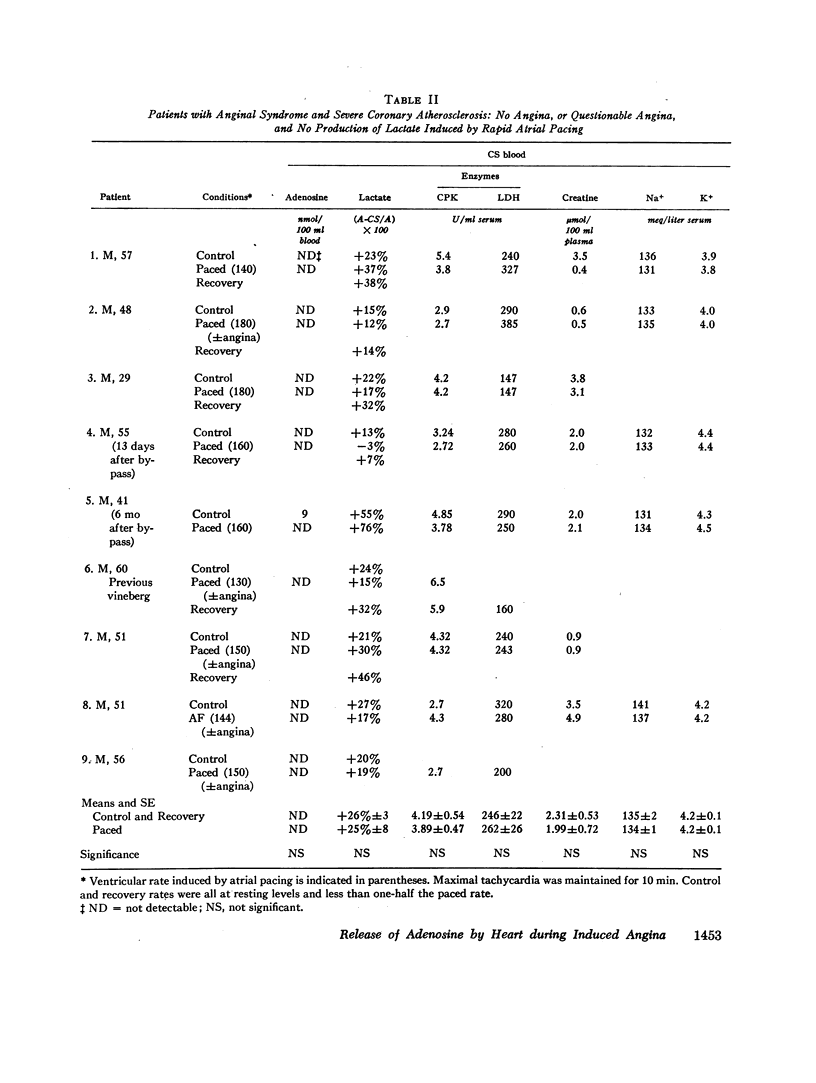
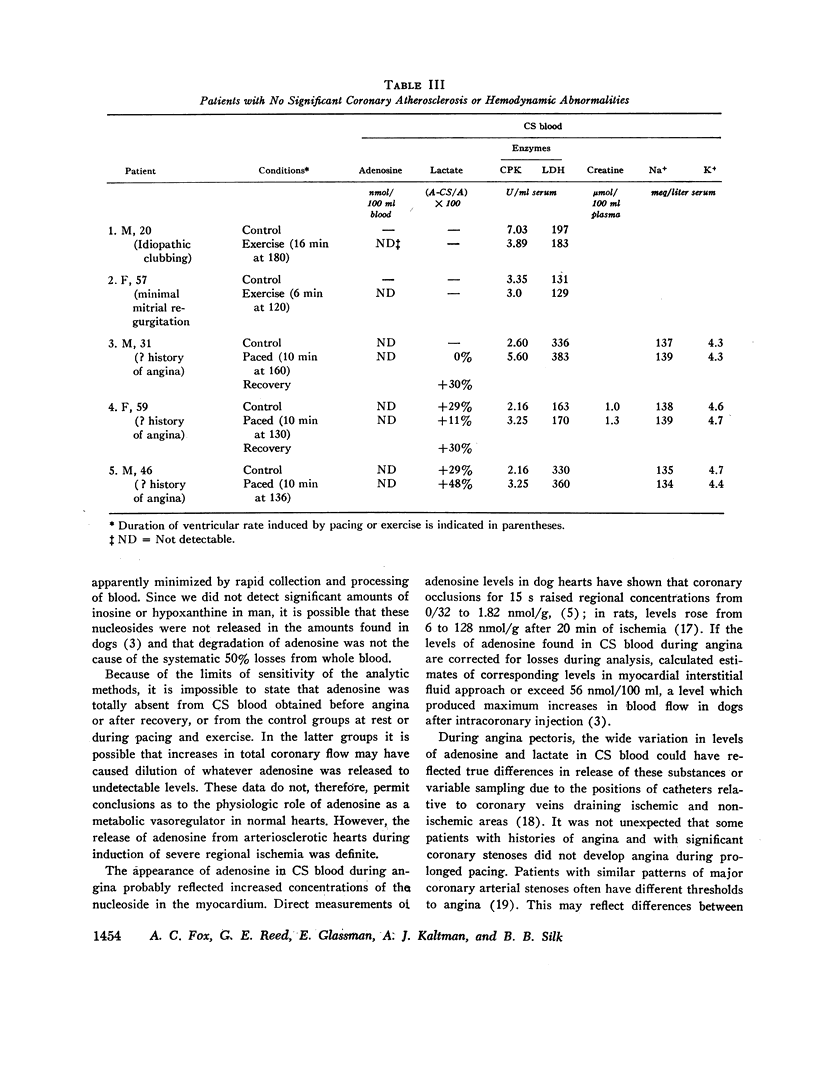
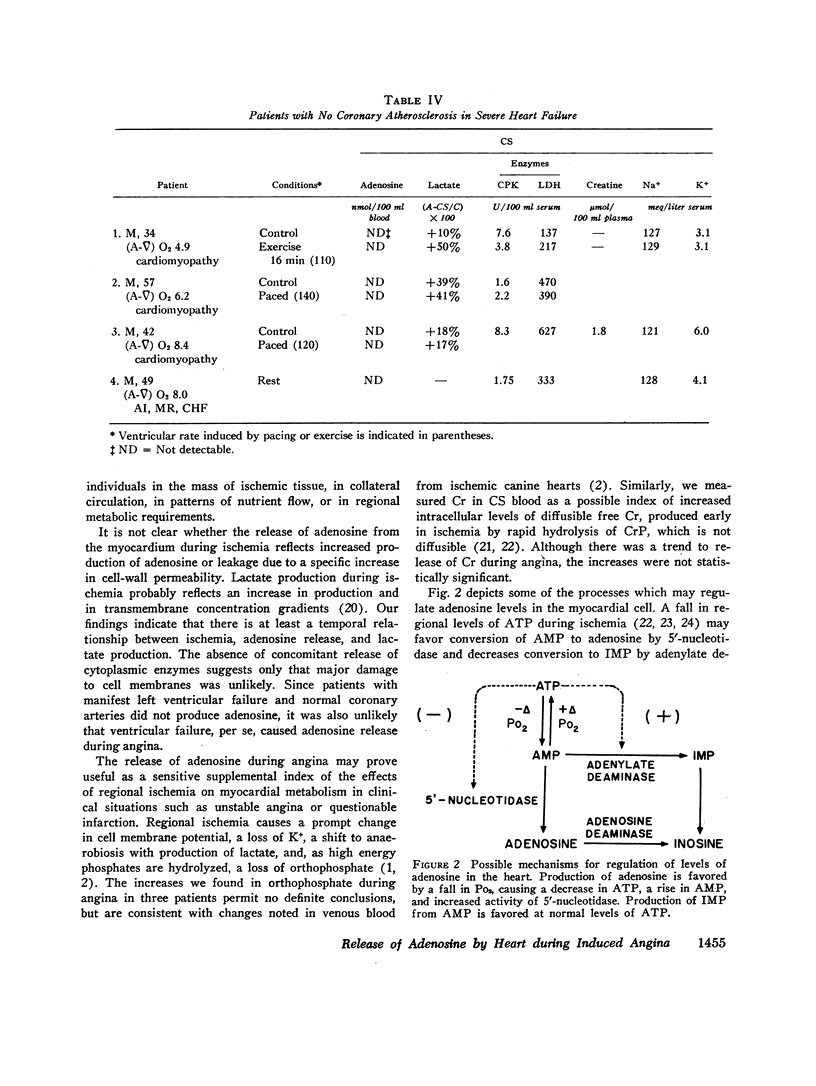
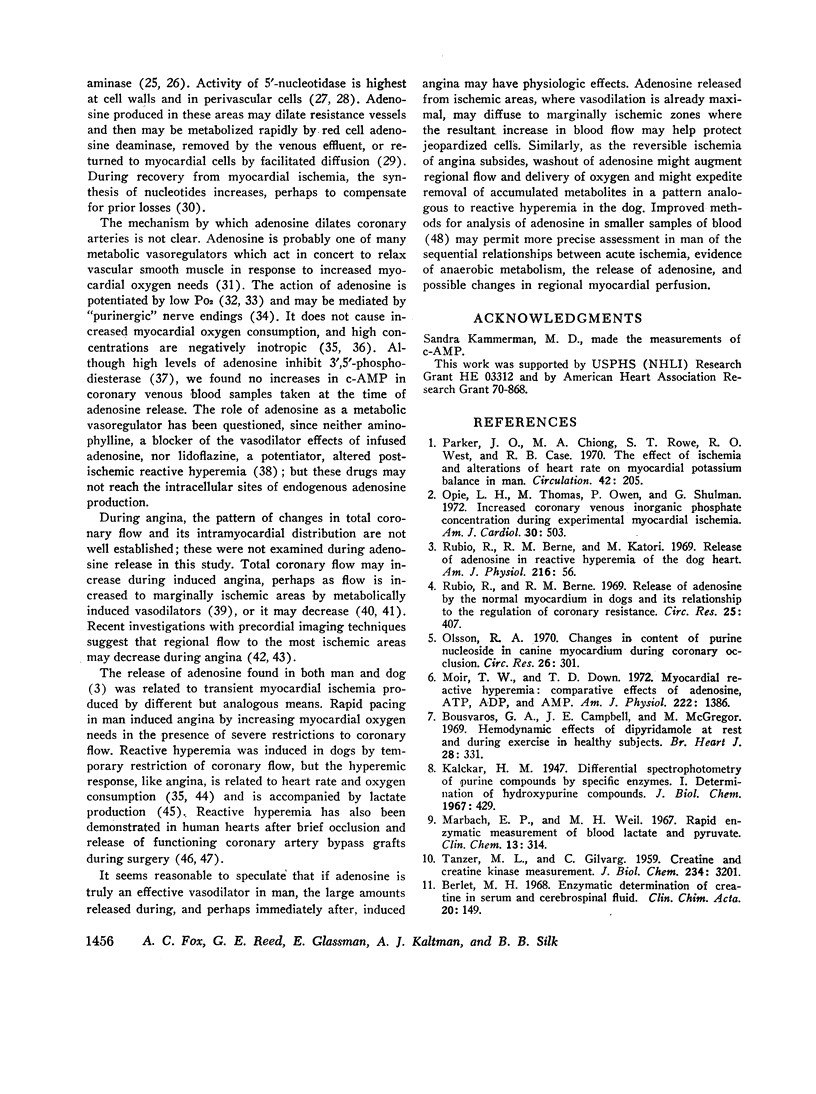
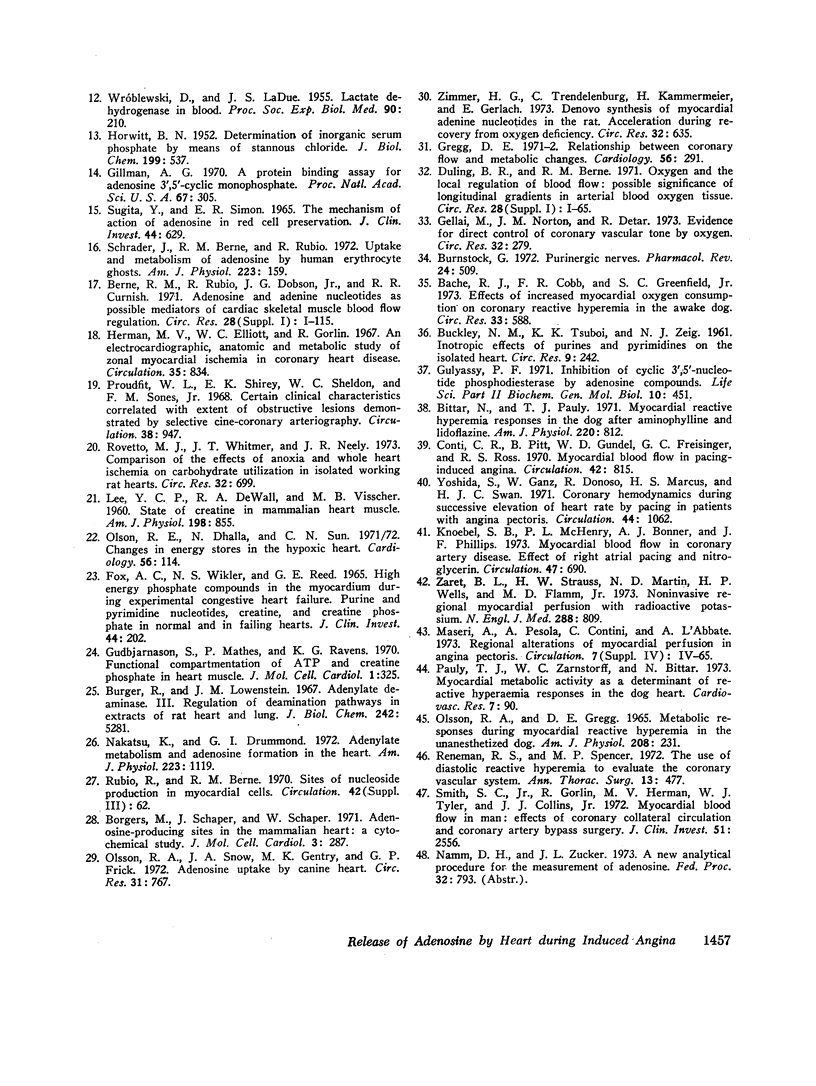
Selected References
These references are in PubMed. This may not be the complete list of references from this article.
- Bache R. J., Cobb F. R., Greenfield J. C., Jr Effects of increased myocardial oxygen consumption on coronary reactive hyperemia in the awake dog. Circ Res. 1973 Nov;33(5):588–596. doi: 10.1161/01.res.33.5.588. [DOI] [PubMed] [Google Scholar]
- Berlet H. H. Enzymatic determination of creatine in serum and cerebrospinal fluid. Clin Chim Acta. 1968 Apr;20(1):149–154. doi: 10.1016/0009-8981(68)90398-7. [DOI] [PubMed] [Google Scholar]
- Berne R. M., Rubio R., Dobson J. G., Jr, Curnish R. R. Adenosine and adenine nucleotides as possible mediators of cardiac and skeletal muscle blood flow regulation. Circ Res. 1971 Jan;28(Suppl):115+–115+. [PubMed] [Google Scholar]
- Bittar N., Pauly T. J. Myocardial reactive hyperemia responses in the dog after aminophylline and lidoflazine. Am J Physiol. 1971 Mar;220(3):812–815. doi: 10.1152/ajplegacy.1971.220.3.812. [DOI] [PubMed] [Google Scholar]
- Borgers M., Schaper J., Schaper W. Adenosine-producing sites in the mammalian heart: a cytochemical study. J Mol Cell Cardiol. 1971 Dec;3(3):287–296. doi: 10.1016/0022-2828(71)90047-2. [DOI] [PubMed] [Google Scholar]
- Bousvaros G. A., Campbell J. E., McGregor M. Haemodynamic effects of dipyridamole at rest and during exercise in healthy subjects. Br Heart J. 1966 May;28(3):331–334. doi: 10.1136/hrt.28.3.331. [DOI] [PMC free article] [PubMed] [Google Scholar]
- Burger R., Lowenstein J. M. Adenylate deaminase. 3. Regulation of deamination pathways in extracts of rat heart and lung. J Biol Chem. 1967 Nov 25;242(22):5281–5288. [PubMed] [Google Scholar]
- Burnstock G. Purinergic nerves. Pharmacol Rev. 1972 Sep;24(3):509–581. [PubMed] [Google Scholar]
- Conti C. R., Pitt B., Gundel W. D., Friesinger G. C., Ross R. S. Myocardial blood flow in pacing-induced angina. Circulation. 1970 Nov;42(5):815–825. doi: 10.1161/01.cir.42.5.815. [DOI] [PubMed] [Google Scholar]
- FOX A. C., WIKLER N. S., REED G. E. HIGH ENERGY PHOSPHATE COMPOUNDS IN THE MYOCARDIUM DURING EXPERIMENTAL CONGESTIVE HEART FAILURE. PURINE AND PYRIMIDINE NUCLEOTIDES, CREATINE, AND CREATINE PHOSPHATE IN NORMAL AND IN FAILING HEARTS. J Clin Invest. 1965 Feb;44:202–218. doi: 10.1172/JCI105135. [DOI] [PMC free article] [PubMed] [Google Scholar]
- Gellai M., Norton J. M., Detar R. Evidence for direct control of coronary vascular tone by oxygen. Circ Res. 1973 Feb;32(2):279–289. doi: 10.1161/01.res.32.2.279. [DOI] [PubMed] [Google Scholar]
- Gilman A. G. A protein binding assay for adenosine 3':5'-cyclic monophosphate. Proc Natl Acad Sci U S A. 1970 Sep;67(1):305–312. doi: 10.1073/pnas.67.1.305. [DOI] [PMC free article] [PubMed] [Google Scholar]
- Gottschalk C. W. Function of the chronically diseased kidney. The adaptive nephron. Circ Res. 1971 May;28(5 Suppl):1–13. doi: 10.1161/01.res.28.5.ii-1. [DOI] [PubMed] [Google Scholar]
- Gregg D. E. Relationship between coronary flow and metabolic changes. Cardiology. 1971;56(1):291–301. doi: 10.1159/000169373. [DOI] [PubMed] [Google Scholar]
- Gudbjarnason S., Mathes P., Ravens K. G. Functional compartmentation of ATP and creatine phosphate in heart muscle. J Mol Cell Cardiol. 1970 Sep;1(3):325–339. doi: 10.1016/0022-2828(70)90009-x. [DOI] [PubMed] [Google Scholar]
- Gulyassy P. F. Inhibition of cyclic 3',5'-nucleotide phosphodiesterase by adenine compounds. Life Sci II. 1971 Apr 22;10(8):451–461. doi: 10.1016/0024-3205(71)90307-9. [DOI] [PubMed] [Google Scholar]
- HORWITT B. N. Determination of inorganic serum phosphate by means of stannous chloride. J Biol Chem. 1952 Dec;199(2):537–541. [PubMed] [Google Scholar]
- Herman M. V., Elliott W. C., Gorlin R. An electrocardiographic, anatomic, and metabolic study of zonal myocardial ischemia in coronary heart disease. Circulation. 1967 May;35(5):834–846. doi: 10.1161/01.cir.35.5.834. [DOI] [PubMed] [Google Scholar]
- Knoebel S. B., McHenry P. L., Bonner A. J., Phillips J. F. Myocardial blood flow in coronary artery disease. Effect of right atrial pacing and nitroglycerin. Circulation. 1973 Apr;47(4):690–696. doi: 10.1161/01.cir.47.4.690. [DOI] [PubMed] [Google Scholar]
- LEE Y. C., DEWALL R. A., VISSCHER M. B. State of creatine in mammalian heart muscle. Am J Physiol. 1960 Apr;198:855–858. doi: 10.1152/ajplegacy.1960.198.4.855. [DOI] [PubMed] [Google Scholar]
- Marbach E. P., Weil M. H. Rapid enzymatic measurement of blood lactate and pyruvate. Use and significance of metaphosphoric acid as a common precipitant. Clin Chem. 1967 Apr;13(4):314–325. [PubMed] [Google Scholar]
- Moir T. W., Downs T. D. Myocardial reactive hyperemia: comparative effects of adenosine, ATP, ADP, and AMP. Am J Physiol. 1972 Jun;222(6):1386–1390. doi: 10.1152/ajplegacy.1972.222.6.1386. [DOI] [PubMed] [Google Scholar]
- Nakatsu K., Drummond G. I. Adenylate metabolism and adenosine formation in the heart. Am J Physiol. 1972 Nov;223(5):1119–1127. doi: 10.1152/ajplegacy.1972.223.5.1119. [DOI] [PubMed] [Google Scholar]
- OLSSON R. A., GREGG D. E. METABOLIC RESPONSES DURING MYOCARDIAL REACTIVE HYPEREMIA IN THE UNANESTHETIZED DOG. Am J Physiol. 1965 Feb;208:231–236. doi: 10.1152/ajplegacy.1965.208.2.231. [DOI] [PubMed] [Google Scholar]
- Olson R. E., Dhalla N. S., Sun C. N. Changes in energy stores in the hypoxic heart. Cardiology. 1971;56(1):114–124. doi: 10.1159/000169351. [DOI] [PubMed] [Google Scholar]
- Olsson R. A. Changes in content of purine nucleoside in canine myocardium during coronary occlusion. Circ Res. 1970 Mar;26(3):301–306. doi: 10.1161/01.res.26.3.301. [DOI] [PubMed] [Google Scholar]
- Olsson R. A., Snow J. A., Gentry M. K., Frick G. P. Adenosine uptake by canine heart. Circ Res. 1972 Nov;31(5):767–778. doi: 10.1161/01.res.31.5.767. [DOI] [PubMed] [Google Scholar]
- Opie L. H., Thomas M., Owen P., Shulman G. Increased coronary venous inorganic phosphate concentrations during experimental myocardial ischemia. Am J Cardiol. 1972 Oct;30(5):503–513. doi: 10.1016/0002-9149(72)90041-0. [DOI] [PubMed] [Google Scholar]
- Parker J. O., Chiong M. A., West R. O., Case R. B. The effect of ischemia and alterations of heart rate on myocardial potassium balance in man. Circulation. 1970 Aug;42(2):205–217. doi: 10.1161/01.cir.42.2.205. [DOI] [PubMed] [Google Scholar]
- Pauly T. J., Zarnstorff W. C., Bittar N. Myocardial metabolic activity as a determinant of reactive hyperaemia responses in the dog heart. Cardiovasc Res. 1973 Jan;7(1):90–94. doi: 10.1093/cvr/7.1.90. [DOI] [PubMed] [Google Scholar]
- Proudfit W. L., Shirey E. K., Sheldon W. C., Sones F. M., Jr Certain clinical characteristics correlated with extent of obstructive lesions demonstrated by selective cine-coronary arteriography. Circulation. 1968 Nov;38(5):947–954. doi: 10.1161/01.cir.38.5.947. [DOI] [PubMed] [Google Scholar]
- Reneman R. S., Spencer M. P. The use of diastolic reactive hyperemia to evaluate the coronary vascular system. Ann Thorac Surg. 1972 May;13(5):477–487. doi: 10.1016/s0003-4975(10)65161-2. [DOI] [PubMed] [Google Scholar]
- Rovetto M. J., Whitmer J. T., Neely J. R. Comparison of the effects of anoxia and whole heart ischemia on carbohydrate utilization in isolated working rat hearts. Circ Res. 1973 Jun;32(6):699–711. doi: 10.1161/01.res.32.6.699. [DOI] [PubMed] [Google Scholar]
- Rubio R., Berne R. M., Katori M. Release of adenosine in reactive hyperemia of the dog heart. Am J Physiol. 1969 Jan;216(1):56–62. doi: 10.1152/ajplegacy.1969.216.1.56. [DOI] [PubMed] [Google Scholar]
- Rubio R., Berne R. M. Release of adenosine by the normal myocardium in dogs and its relationship to the regulation of coronary resistance. Circ Res. 1969 Oct;25(4):407–415. doi: 10.1161/01.res.25.4.407. [DOI] [PubMed] [Google Scholar]
- SUGITA Y., SIMON E. R. THE MECHANISM OF ACTION OF ADENINE IN RED CELL PRESERVATION. J Clin Invest. 1965 Apr;44:629–642. doi: 10.1172/JCI105176. [DOI] [PMC free article] [PubMed] [Google Scholar]
- Schrader J., Berne R. M., Rubio R. Uptake and metabolism of adenosine by human erythrocyte ghosts. Am J Physiol. 1972 Jul;223(1):159–166. doi: 10.1152/ajplegacy.1972.223.1.159. [DOI] [PubMed] [Google Scholar]
- Smith S. C., Jr, Gorlin R., Herman M. V., Taylor W. J., Collins J. J., Jr Myocardial blood flow in man: effects of coronary collateral circulation and coronary artery bypass surgery. J Clin Invest. 1972 Oct;51(10):2556–2565. doi: 10.1172/JCI107072. [DOI] [PMC free article] [PubMed] [Google Scholar]
- TANZER M. L., GILVARG C. Creatine and creatine kinase measurement. J Biol Chem. 1959 Dec;234:3201–3204. [PubMed] [Google Scholar]
- WROBLEWSKI F., LADUE J. S. Lactic dehydrogenase activity in blood. Proc Soc Exp Biol Med. 1955 Oct;90(1):210–213. doi: 10.3181/00379727-90-21985. [DOI] [PubMed] [Google Scholar]
- Yoshida S., Ganz W., Donoso R., Marcus H. S., Swan H. J. Coronary hemodynamics during successive elevation of heart rate by pacing in subjects with angina pectoris. Circulation. 1971 Dec;44(6):1062–1071. doi: 10.1161/01.cir.44.6.1062. [DOI] [PubMed] [Google Scholar]
- Zaret B. L., Strauss H. W., Martin N. D., Wells H. P., Jr, Flamm M. D., Jr Noninvasive regional myocardial perfusion with radioactive potassium. Study of patients at rest, with exercise and during angina pectoris. N Engl J Med. 1973 Apr 19;288(16):809–812. doi: 10.1056/NEJM197304192881602. [DOI] [PubMed] [Google Scholar]
- Zimmer H. G., Trendelenburg C., Kammermeier H., Gerlach E. De novo synthesis of myocardial adenine nucleotides in the rat. Acceleration during recovery from oxygen deficiency. Circ Res. 1973 May;32(5):635–642. doi: 10.1161/01.res.32.5.635. [DOI] [PubMed] [Google Scholar]


